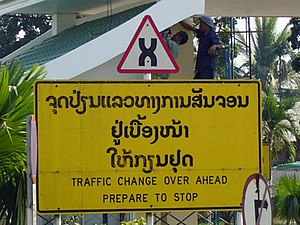First Thai–Lao Friendship Bridge
Thai–Lao Friendship Bridge | |
|---|---|
| Coordinates | 17°52′42″N 102°42′56″E / 17.8783°N 102.7156°E |
| Carries | Motor vehicles |
| Crosses | Mekong River, Thai-Lao Border |
| Locale | Nong Khai, Nong Khai province Vientiane, Vientiane Province |
| Characteristics | |
| Total length | 1.17 km |
| Width | 3.5 m and 1.5 m |
| Location | |
 | |


The First Thai–Lao Friendship Bridge (Thai: สะพานมิตรภาพ ไทย-ลาว แห่งที่ 1, pronounced [sàpʰaːn míttràpʰâːp tʰaj laːw hɛ̀ŋ tʰîː nɯ̀ŋ]; Lao: ຂົວມິດຕະພາບ ລາວ-ໄທ ແຫ່ງທຳອິດ, [kʰǔə mittapʰâːp láːw tʰaj hɛŋ tʰám ǐt]) is a bridge over the Mekong, connecting Nong Khai province and the city of Nong Khai in Thailand with Vientiane Prefecture in Laos - the city of Vientiane is approximately 20 km from the bridge. With a length of 1,170m (0.73 mi), the bridge has two 3.5m (11 ft 6 in) wide road lanes, two 1.5m (4 ft 11 in) wide footpaths and a single 1000 gauge railway line in the middle, straddling the narrow central reservation.
- The rail gauge is 1000mm.
- The loading gauge might be 3000mm.
- The structure gauge (roughly equal to a road lane) might be about 4000mm.
History
Opened on April 8, 1994, it was the first bridge across the lower Mekong, and the second on the full course of the Mekong. [citation needed]
The cost was about US$30 million, funded by the Australian government as development aid for Laos.[1]
The bridge was built by Australian companies as a demonstration of the capabilities of their ability to complete major infrastructural projects in Southeast Asia.
The official name of the bridge was changed by the addition of "First" after the Second Thai–Lao Friendship Bridge further south opened in January 2007.
Road traffic
Traffic on the bridge drives on the left, as in Thailand, while traffic in Laos drives on the right. The changeover at the Lao end, just before the border post, is controlled by traffic lights.
A shuttle bus service operates across the bridge, between the Lao and Thai border posts.
The Bridge is part of the AH12 Asian Highway Network.
Railway
A metre-gauge track from the new Nong Khai station runs along the centre of the bridge. Road traffic is stopped when a train is crossing.
On March 20, 2004, an agreement between the Thai and Lao governments was signed to extend the railway to Thanaleng Railway Station in Laos, about 3.5 km (2.2 mi) from the bridge. This will be the first railway link to Laos (but not the first railway, as a short portage line once existed). The Thai government agreed to finance the line through a combination of grant and loan.[2] Construction formally began on January 19, 2007.[3] Test trains began running on July 4, 2008.[2] Formal inauguration occurred on March 5, 2009.[4]
On February 22, 2006, approval of funding for the rail line from Thanaleng Railway Station to Vientiane, about 9 km, was announced by the French Development Agency.[5]
In November 2010 plans to extend the service from Tha Nalaeng to Vientiane were abandoned.[6] A posited high-speed rail link from China to Thailand through Laos would make the extension redundant. It would also necessitate the construction of a new bridge near to the current First Friendship Bridge.
References
- ^ http://www.ausaid.gov.au/publications/focus/feb09/focus_feb09_08.pdf
- ^ a b "Testing takes train into Laos". Railway Gazette International. 2008-07-07.
- ^ "Laos link launched". Railway Gazette International. 2007-03-01.
- ^ "Thai-Lao train service launched". Bangkok Post. 2009-05-03.
- ^ Saeung, Sopaporn (February 23, 2006). "France okays Thai-Laos railway link", The Nation.
- ^ "Laos scraps full rail link to Nong Khai", Bangkok Post, November 6, 2010
